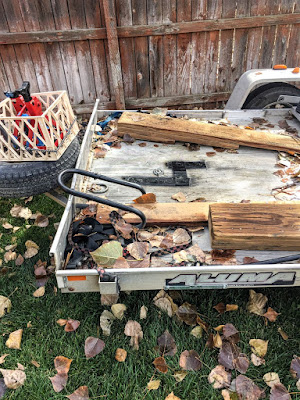I have been using an Aluma 638 Aluminum Trailer since before 2016 to haul one of my two Ural Patrol sidecar rigs when camping with the URRV.
I've pretty much put the thing through terrain and situations that it wasn't really designed for and which aluminum just couldn't withstand long term repeated stress.
Stretching the trailer's tongue by two feet to gain clearance distance didn't help as it most likely added undue stress where the beam mated to the trailer bed's longitudinal support beams.
Along with stretching the tongue and gaining clearance, carrying the TW200 on the forward edge of the trailer bed didn't help things either!
Not supporting the rear edge of the trailer when doing loading/unloading operations didn't help either, something I learned about today thanks to RichardM.
I'd tried having additional aluminum welds to secure the tongue to the beams under the trailer....so pretty sure it wouldn't come off but the cracks in the beams themselves caused worry:
So, I'll be traveling with a couple of small jack stands to use when loading/unloading the sidecar rig onto the trailer. This should alleviate some of the stress when a 800 lb sidecar rig is driven onto or off of the trailer!
My next trailer, will be a steel trailer....yep, much heavier but stronger. But not anytime soon, I hope.





7 comments:
Thanks for posting this Dom, you got me thinking as I have an aluminum trailer for hauling the sidecar rigs too. My BMW rig weighs more than your Ural, and the Triumph sidecamper rig weighs as much as two Ural's.
So you are saying using two crank jacks at either rear corner is the support needed to resist cracking when loading and unloading the trailer, and it's not the hauling over rough potted roads causing the cracking?
The jack stands at the rear corners will help CCjon but the aluminum bed on my trailer has proven not strong enough for point loads such as under the pusher wheel when the rig is tied down....that was where the first cracks appeared years ago. The googling I did seemed mostly to relate to preventing large loads on larger trailers from lifting the tongue from the tow hitch and causing stress and such, not to mention if heavy enough...lifting the tow vehicle’s rear wheels off the ground and ensuing chaos. In my case I’m hoping it’ll help....I’m pretty sure reducing the “flex” caused when riding the rig onto the trailer is the main culprit but perhaps it’s also my aluminum trailer just not designed for the way I use it? As I mentioned, extending the tongue AND for a while carrying the TW200 on the forward edge of the trailer bed didn’t help. I’ll amend the posting to list that as a contributing factor as well.
I’m listening and trying to pay attention but my focus remains on your green grass.
Coop, the green grass now lies under an inch or so of the white stuff....and about two more inches expected
What is the gross weight rating for your trailer? Are you exceeding it?
Is age of the trailer a factor?
If the princial crack area is under the pusher tire, maybe a 3x3 piece of plywood is the answer to spread the load.
CCjon, GWR is 2000 lbs with 1630 usable so no, not exceeding weight limits.
The trailer was built 2012 so age probably not a factor. I think as long as you don't do stupid things like I did, such as extending the tongue and not using supports in the rear when loading and unloading the rigs, you should be fine.
Post a Comment